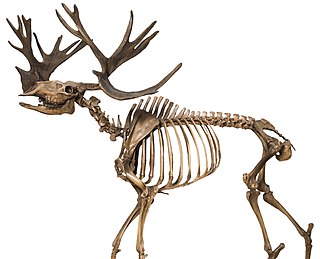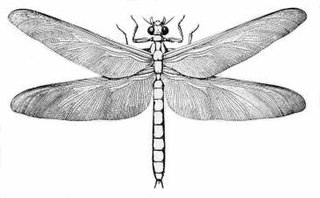 W
WAnchisaurus is a genus of basal sauropodomorph dinosaur. It lived during the Early Jurassic Period, and its fossils have been found in the red sandstone of the Portland Formation, northeastern United States, which was deposited from the Hettangian age into the Sinemurian age, between about 200 and 195 million years ago. Until recently it was classed as a member of Prosauropoda. The genus name Anchisaurus comes from the Greek αγχι anchi-; "near, close" + Greek σαυρος ; "lizard". Anchisaurus was coined as a replacement name for "Amphisaurus", which was itself a replacement name for Hitchcock's "Megadactylus", both of which had already been used for other animals.
 W
WCamptosaurus is a genus of plant-eating, beaked ornithischian dinosaurs of the Late Jurassic period of western North America. The name means 'flexible lizard'.
 W
WCervalces is an extinct deer genus that lived during the Pliocene and Pleistocene epochs. Cervalces gallicus, the ancestral species, lived in Europe from the Pliocene to the Pleistocene strata. Cervalces scotti, the stag-moose, lived in Pleistocene North America. Cervalces latifrons, the broad-fronted moose, and Cervalces carnutorum were found in Pleistocene Europe and Asia.
 W
WCervalces scotti, the elk moose or stag-moose, is an extinct species of large moose that lived in North America during the Late Pleistocene epoch. It had palmate antlers that were more complex than those of a moose and a muzzle more closely resembling that of a typical deer. It is the only known North American member of the genus Cervalces.
 W
WCochleosaurus is a name of a tetrapod belonging to Temnospondyli, which lived during the late Carboniferous period. The great abundance of its remains have been found in the Kladno Formation of the Czech Republic, near Nýřany in Central Europe and in the Morien Group of Nova Scotia in North America. It was a creature of medium size, measuring 120-160 centimeters. It is believed that Cochleosaurus was a semiaquatic ambush predator, hunting like modern crocodiles. Czech paleontologist Antonin Fritsch named the genus in 1885 in reference to the spoon-shaped processes on the supra-occipital bones at the back of the skull.
 W
WGryposuchus is an extinct genus of gavialoid crocodilian. It is the type genus of the subfamily Gryposuchinae. Fossils have been found from Argentina, Colombia, Venezuela, Brazil and the Peruvian Amazon. The genus existed during the Miocene epoch. One recently described species, G. croizati, grew to an estimated length of 10 metres (33 ft).
 W
WHainosaurus is an extinct genus of marine reptiles belonging to the mosasaur family. It is one of the largest mosasaurs, though its size has been revised more than once. At first it was estimated to be 17 metres (56 ft), and the largest mosasaurid. During the 1990s, its size was revised to 15 metres (49 ft) long; more recently, Johan Lindgren estimated that it reached lengths of up to 12.2 metres (40 ft). It was one of the top marine predators of the Late Cretaceous. Like other giant mosasaurs, this giant predator preyed on turtles, plesiosaurs, pterosaurs, cephalopods, sharks, fish, and smaller mosasaurs.
 W
WThe steppe mammoth is an extinct species of Elephantidae that ranged over most of northern Eurasia during the late Early and Middle Pleistocene, approximately 1.7 million-200,000 years ago. It evolved in Siberia during the Early Pleistocene from Mammuthus meridionalis. It was the first stage in the evolution of the steppe and tundra elephants and the ancestor of the woolly mammoth and Columbian mammoth of the later Pleistocene. Populations of steppe mammoth may have persisted in northern China and Mongolia as recently as 33,000 years ago.
 W
WMeganeura is a genus of extinct insects from the Late Carboniferous, which resembled and are related to the present-day dragonflies and damselflies. With wingspans ranging from 65 cm (25.6 in) to over 70 cm (28 in), M. monyi is one of the largest-known flying insect species. Meganeura were predatory, with their diet mainly consisting of other insects. Meganeura belongs to the Meganeuridae, a family including other similarly giant dragonfly-like insects ranging from the Late Carboniferous to Middle Permian.
 W
WNeosodon was a genus of sauropod dinosaur from the Late Tithonian-age Upper Jurassic Sables et Gres a Trigonia gibbosa of Départment du Pas-de-Calais, France. It has never been formally given a species name, but is often seen as N. praecursor, which actually comes from a different animal. Often in the past, it had been assigned to the wastebasket taxon Pelorosaurus, but restudy has suggested that it could be related to Turiasaurus, a roughly-contemporaneous giant Spanish sauropod. It is only known from six teeth.
 W
WPachyrukhos is an extinct genus of mammals from the Late Oligocene to Middle Miocene of Argentina and Chile, South America.
 W
WParasuchus is an extinct genus of phytosaur known from the Late Triassic of Andhra Pradesh and Madhya Pradesh, India. It contains a single species, Parasuchus hislopi.
 W
WStegops is an extinct genus of euskelian temnospondyl from the Late Carboniferous of the eastern United States. Fossils are known from the Pennsylvanian coal deposits of Linton, Ohio. It was once classified in the eryopoid family Zatrachydidae because it and other zatrachydids have spikes extending from the margins of its skull, but it is now classified as a dissorophoid that independently evolved spikes. Stegops was first named by American paleontologist Edward Drinker Cope in 1885, with his description of the type species Stegops divaricata. Cope had also named a species of Sauropleura from Linton in 1875, which he called Sauropleura newberryi. This species was later synonymized with Stegops divaricata when the type specimen of S. newberryi was prepared and found to be a large specimen of Stegops.
 W
WStereosternum tumidum is an extinct genus of mesosaur marine reptile from the Early Permian of Brazil and also the Great Karoo Basin of South Africa. The taxon mesosaur is a monophyletic group containing Brazilosaurus sanpauloensis and Mesosaurus tenuidens.
 W
WTetheopsis is an extinct genus of Uintatheriidae.
 W
WTitanichthys is a genus of giant, aberrant marine placoderm from shallow seas of the Late Devonian of Morocco, Eastern North America, and possibly Europe. Many of the species approached Dunkleosteus in size and build. Unlike its relative, however, the various species of Titanichys had small, ineffective-looking mouth-plates that lacked a sharp cutting edge. It is assumed that Titanichthys was a filter feeder that used its capacious mouth to swallow or inhale schools of small, anchovy-like fish, or possibly krill-like zooplankton, and that the mouth-plates retained the prey while allowing the water to escape as it closed its mouth. A study has since confirmed this assumption as its jaws are functionally closer to that of filter feeders like baleen whales and basking sharks, and it appears to have developed from benthic durophagists that became pelagic suspension feeders. This would have made it the first large sized vertebrate filter feeder.